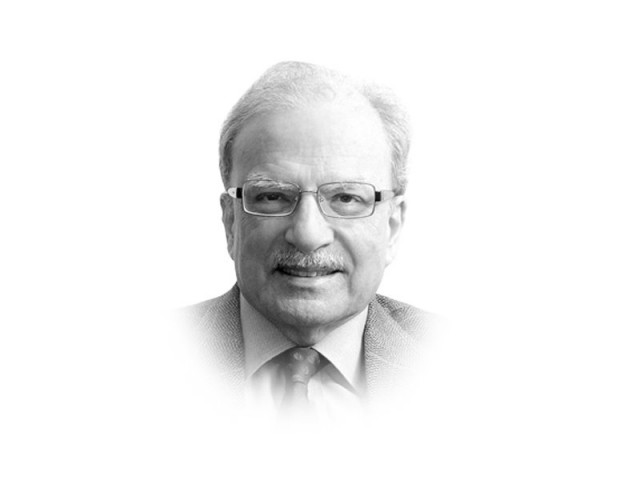Growing anti-immigration sentiment in the US
The current American president is mentally unstable and not fit to remain in the office

The writer is a former caretaker finance minister and served as vice-president at the World Bank
According to a report in The Washington Post, “Trump’s ping-ponging from deal making to feuding, from elation to fury, has come to define the contentious immigration talks between the White House and Congress, perplexing members of both parties as they navigate the president’s vulgarities, his combativeness and his willingness to change his position. This behaviour confirmed several minds that the current American president is mentally unstable and not fit to remain in the office.” The way he has talked about Pakistan in public — on August 21st and again on December 17th — the latter when his administration released the formal United States foreign policy strategy is one other measure of the man’s unsteady behaviour. Trump’s approach towards Pakistanis and Pakistan will significantly affect the making of foreign policy by Islamabad.
Pakistanis now have a growing presence in the United States. The exact count is not available; estimates range from 450,000 to 800,000. The lower estimate is from the Migration Policy Institute (MPI) while the higher number is from the Pakistan embassy in Washington. According to the MPI, the Pakistani diaspora accounts for merely 0.8 per cent of the total US foreign-born population but is growing rapidly. Nearly two-thirds of all Pakistani immigrants to the United States are American citizens — the third-highest naturalisation rate of a group of 15 diaspora communities studied by the MPI. According to a report by the Asian American Centre for Justice, Pakistani-Americans comprise the second fastest growing Asian-American ethnic group in the country. Their numbers have doubled between 2000 and 2010 from just over 200,000 to 450,000. The United States is now the fifthlargest country for Pakistani migrants. Saudi Arabia is the most favoured destination for Pakistanis leaving their country. But there is a major difference between the Arab nations and the United States. While the American system allows the new arrivals to eventually become citizens, that option is not available in most of the Arab world.
High-earning professionals constitute the vast majority of Pakistanis who have arrived and settled in the United States. This is the reason why the average household income for the Pakistani-Americans is well above the national average. This is about the same as the Indians in the United States. But there is one important difference between these two communities. The America-Indians now have a visible presence in the senior echelons of the American political system. A few years ago, of the 50 governors in the country, two were of Indian origin. One of them, Nicki Haley of South Carolina, is now the United States’ ambassador to the United Nations. There is a senator and a couple of members in the House of Representatives of Indian origin. A person of Indian origin is the deputy information adviser in the White House. Pakistanis believe that the presence of Indians in senior policymaking positions has contributed to the anti-Pakistan stance by the Trump administration. Haley, for instance, told the press that “we have asked the Indians to keep an eye on Pakistan.”
The proportion of non-European migrants to the United States increased significantly after the approval by Congress of the US Immigration and Nationality Act of 1965. This initiative was taken by then president Lyndon Johnson. The act removed immigration quotas based on national origin. The idea was to open the country to non-Europeans. President Johnson was not concerned that that would result in increasing the proportion of the non-whites in the country’s population. That happened, as the opportunities available in the United States to those from Asia and Africa were more numerous than was the case in Europe. What came to be known as the process of globalisation also put the United States on the radar screens of the ambitious in these continents, who had the skills that were needed in the United States. The Pakistani diasporas worldwide are a major source of foreign capital inflows into the country. They come in the form of remittances that averaged $2.7 billion a quarter from 2002 until 2017. They reached an all-time high of $5.5 billon in the second quarter of 2016. The lowest was $906 million in the third quarter of 2003. The United States is a major source of this inflow.
Those who are already in the United States will stay and see their numbers increase as they add more to their families. However, the growing anti-immigration sentiment will hurt Pakistan in two ways. It is likely that Pakistanis will run into greater scrutiny when they apply for visas. They will also be affected if the Trump administration places some limits on what is called ‘chain migration’. This is the process that allows those who are already in the country to bring in their close relatives. This type of migration has been an important source of addition to the Pakistan-American diaspora.
Published in The Express Tribune, January 22nd, 2018.
Like Opinion & Editorial on Facebook, follow @ETOpEd on Twitter to receive all updates on all our daily pieces.















COMMENTS
Comments are moderated and generally will be posted if they are on-topic and not abusive.
For more information, please see our Comments FAQ